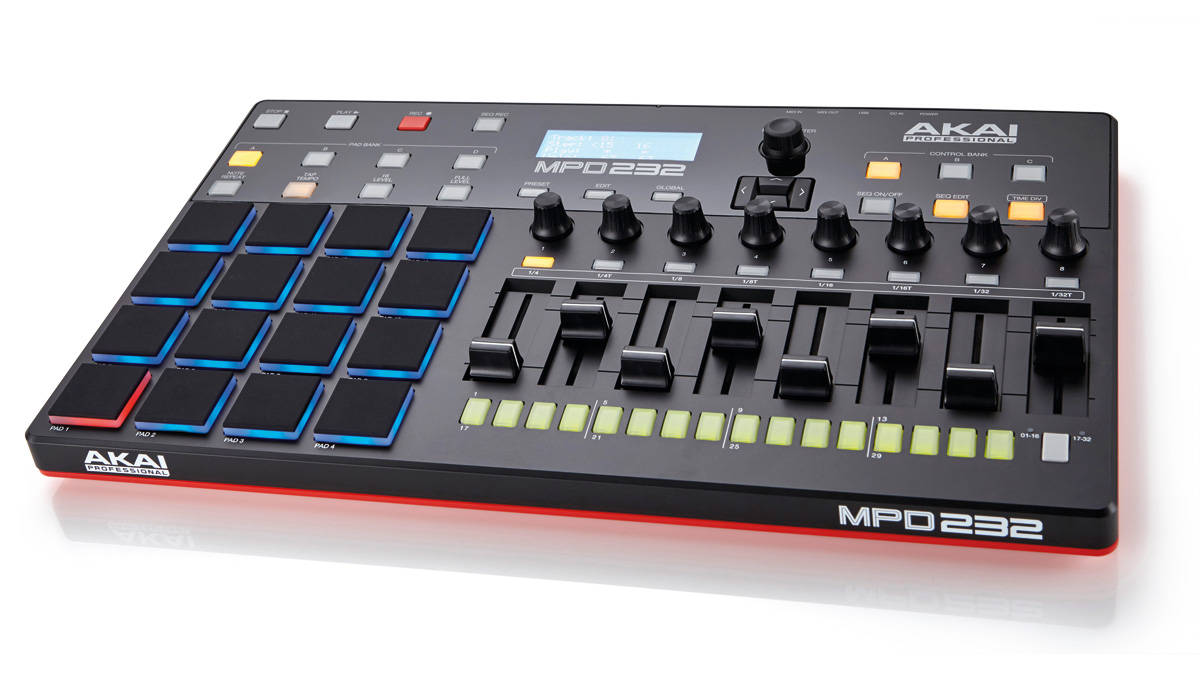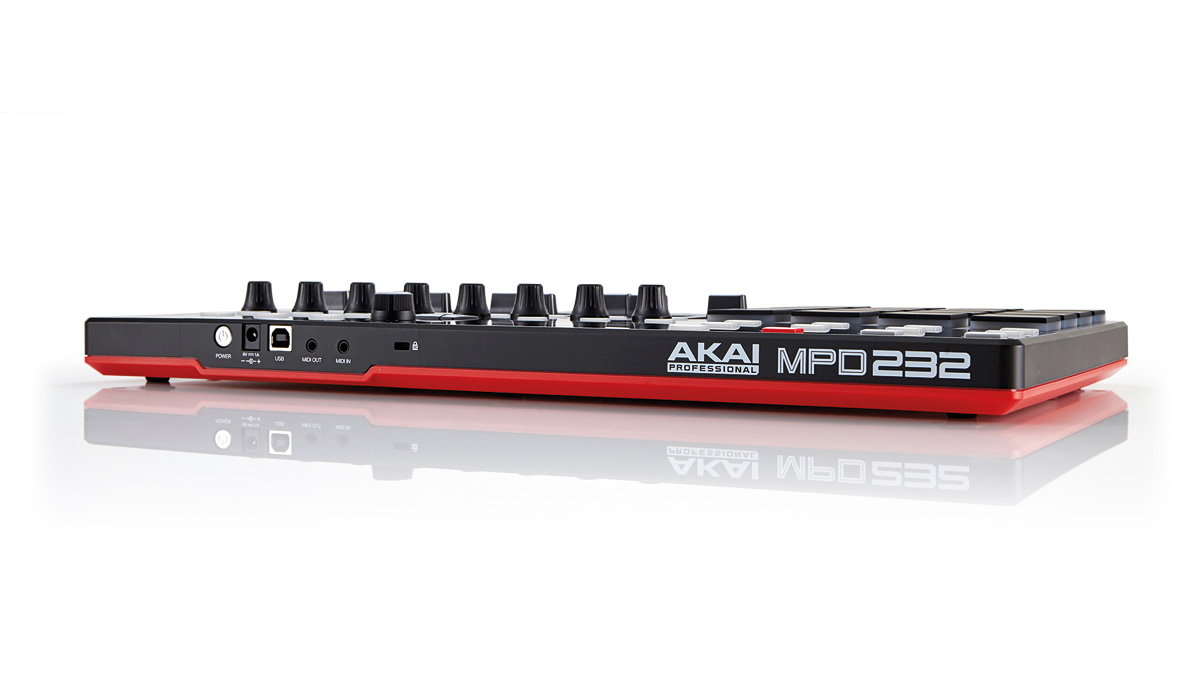MusicRadar Verdict
The MPD2s are intuitive, portable and versatile and the level of control onboard is impressive.
Pros
- +
Solid build. Excellent MPC-style pads.
Cons
- -
Power adapter not supplied. No footswitch.
MusicRadar's got your back

Akai MPD232 Controller

Akai MPD232 Controller
Akai's original MPD16 launched back in 2002. Fast forward to 2015 and here comes the new MPD2 range.
Here we'll be focusing on the new MPD232 with a brief look at the smaller MPD226 and 218 models.
While the outgoing MPD32 looked utilitarian, the MPD232 looks much more inviting. The larger, flatter case is made from smooth black and red plastic and surrounding the screen (which is mainly used for assigning MIDI data/CCs to the 72 assignable controls), the case morphs into shiny black perspex (unfortunately the same fingerprint and scratch-inviting type found on the recent Advance controllers and on Roland's JD-XA synth).
This plastic is also very reflective and shiny which some might find distracting, although in normal lighting conditions it shouldn't be a problem, especially as the panel writing is clear.
Build-wise things are generally solid. The endless rotary dials feel sturdy, the sliders feel tough with little wobble (and they produce smooth MIDI output), plus the yellow backlit buttons click reassuringly.
One concern is that the slider tops can be pulled off and during vigorous slider sessions this could be problematic for some. In addition, none of the slider/pad/button/rotary values appear in the display when pressed/ moved which is a shame - hopefully this can be addressed in an OS update.
Connection-wise, the MPD232's USB port allows the unit to be buss-powered from your computer (and there's MIDI in/out over USB too). In addition, the 232 and 226 can be powered via an optional 6V mains power adaptor (ie they work standalone), though I feel this should have been included in the £190 price - there's also nothing to clamp the wire in place so tread carefully!
There are also two further concerns. Firstly, due to the slimline case, the MIDI in/out ports (used for sending MIDI to and receiving MIDI from external MIDI gear, in addition to the USB port) are on breakout cables. This means more cables to remember for gigs, plus mini jack connections are way less sturdy - this is a disadvantage over the outgoing models with their standard DIN MIDI connections.
The second concern is that the new MPD2s have no footswitch or expression pedal jacks so, if you like to sustain sounds on certain pads or add expression via pedals, you're out of luck!
Pad layout
While the outgoing MPD32 had a more familiar MPC-style layout, the 232 has the pads to the lower left and transport to the far upper left edge with all the tweakable/assignable dials, sliders and buttons (eight dials, eight buttons, eight sliders) to the right. In practice this works okay, though we much prefer having transport controls on the right in general and placed closer to the front edge.
On the 232 you can inadvertently trigger the pads when reaching over to the transport, especially when you're sitting down using it on a desktop. (Note that the transport is used for starting/stopping external hardware sequencers/drum machines or your DAW).
The new pressure/velocity sensitive MPC-style thick pads feel excellent and durable and they're some of the nicest I've used. They respond well to a light touch and their response can be customised to taste in the menus.
It's also great that the pads are illuminated which is useful both on and off stage - this allows you to keep track of everything nicely and they can also be set to any of 16 colours for both on and off modes. Also note that the pads can be set to control note on/off, program changes and bank changes too.
Above the pads are the standard Akai Pad Bank buttons (there are four pad banks here) and you'll also find MPC-style Note Repeat, plus 16 Level and Full Level buttons. There's also a Tap Tempo button which flashes to denote the internal or external MIDI-synchronised tempo. Time divisions for step sequencing and the note repeat function are set by the Time Div button and the eight buttons below the dials, plus there's MPC swing too.
Step sequencer
In keeping with recent trends, there's a decent 32 step x 64 track sequencer onboard which adds a welcome new dimension to the MPD range (it can be MIDI-synchronised and used to control software instruments and/or external MIDI instruments).
To record, hit Seq Rec (Real-time) or Seq On (Step), find the pad you want to record, hit the pad, add in steps via the pads in real time (or using the 16 step buttons at the bottom right), select the next track to record (using any pad or the screen) and repeat! Downsides here are editing is basic, there's no pattern chaining/song mode and no way to assign onboard sequences to pads like an MPC, though you can trigger external sequences/clips from the pads when using the 232 with Ableton (Live Lite is included).
Finally, there are three Control Banks. These allow direct front panel access to 72 real-time parameters, so you have a lot of power for bringing performances to life. If you don't want to use the screen for setting up your custom controller presets, there's a nicely intuitive and elegant USB software editor included for assigning parameters to the 232's controllers (and for sequencing too).
There are also presets for several DAWs included, though like other current Akai products it isn't quite plug-and-play as you'll need to make some manual controller assignments within your chosen DAW (it was relatively painless to set up the 232 with Logic X's 'smart' controls).
All things considered, we really like the MPD232. In most ways it's a worthy upgrade from the outgoing model(s) and it scores extra points for its standalone and sequencing capabilities. It's pretty intuitive, fairly priced and should fit in nicely with most studio/live set-ups.
“Every note counts and fits perfectly”: Kirk Hammett names his best Metallica solo – and no, it’s not One or Master Of Puppets
Ranked: Bon Iver's albums, from Sable, Fable to For Emma, Forever Ago
“Its mission is simple: unleash the power of any amplifier or line-level source without compromise”: Two Notes promises a “watershed” in tube amp control with the Torpedo Reload II









